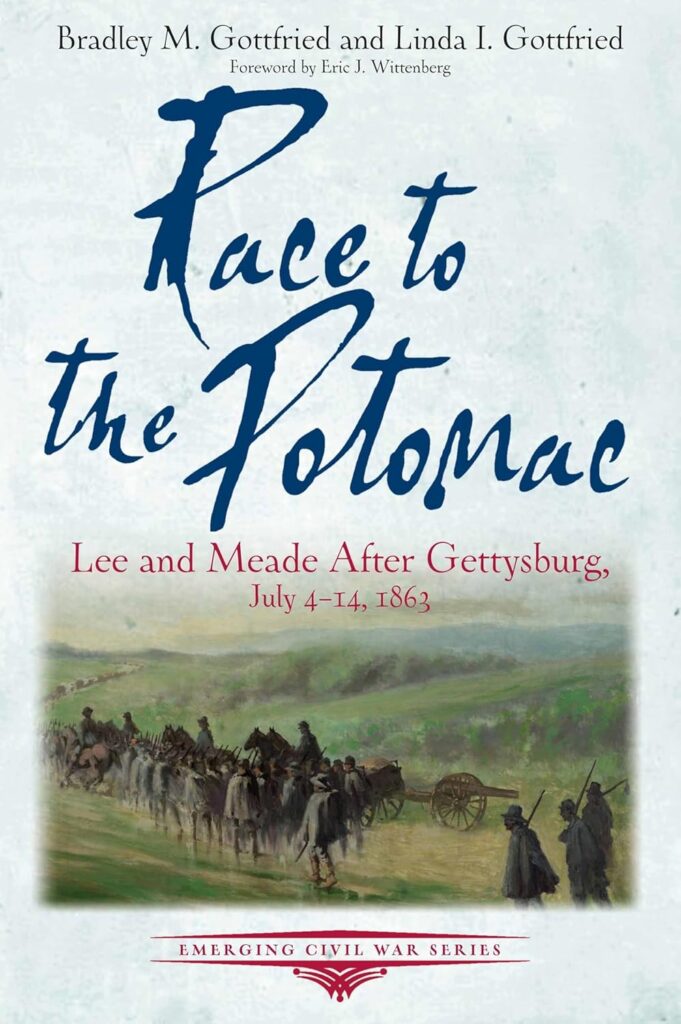By Bradley M. Gottfried and Linda I. Gottfried.
El Dorado Hills, CA: Savas Beatie, 2024.
ISBN 978-1-61121-702-5. Illustrations. Maps. Suggested Reading.
Pp. xxi, 167. $16.95.
The events at Gettysburg, from 1-3 July 1863, endure as the most written-about battle within U.S. military historiography, including numerous treatises, articles, documentaries, and even a major motion picture. Chronologically, many people recognize the stories leading up to 1 July and through the next three days to Pickett’s Charge as the Confederacy’s “high water mark.” However, not as much has been written about the latter part of the campaign of General Robert E. Lee’s retrograde movement from Pennsylvania and Major General George G. Meade’s pursuit south.
Bradley M. Gottfried and Linda I. Gottfried’s work, Race to the Potomac: Lee and Meade After Gettysburg, July 4-14, 1863, as part of the Emerging Civil War Series, presents a concise and introductory history of the weeks following the climactic actions in Pennsylvania. It includes a balanced history, and an opportunity to understand the armies’ post-Gettysburg movements from an automobile tour. The work does not include a bibliography or index. While the publisher, Savas Beatie, offers more in-depth pieces relating to Gettysburg and the events in the weeks following, Gottfried and Gottfried’s shorter popular history remains applicable and appreciable for anyone desiring to know how this chapter in the Civil War ended, including historians of other periods.
Chronologically, the work begins with the terrible weather post-conflict at Gettysburg and concludes with the Confederate defense and withdrawal around Williamsport, Maryland. The authors’ ample focus on cavalry actions south of Gettysburg, near the state line, allows an understanding of the two armies’ movements and skirmishes. The authors highlight the immensity of Meade’s mistake in allowing Lee’s escape south by crossing the Potomac at Falling Waters and into West Virginia. However, they acknowledge Meade’s challenges against the Army of Northern Virginia by including other historians’ perspectives.
Gottfried and Gottfried recognize maneuver, sustainment, fires, engineering, and medical issues the armies faced post-Gettysburg. They address reconnaissance and intelligence issues, including weather and terrain, which affected the armies’ abilities to move swiftly. Their investigation of cavalry actions, essential to understanding the Gettysburg Campaign, spotlight lesser-known battlefields at Smithsburg and Granite Hill. Notably, the authors’ examination and inclusion of signal-related conflicts between Meade and Washington through telegraphs are an important contribution.
Specifically, Race to the Potomac affords an excellent chance for traveling families to comprehend lesser-known historical locations. Additionally, the work is a good introductory reading in preparation for a quick staff ride to cover the greater region northwest of Washington, DC, excluding Antietam, Gettysburg, or Monocacy. Gottfried and Gottfried’s history, including the size of the work, makes for an ideal travel companion for anyone looking for startling moments in Pennsylvania and Maryland’s past, down to the example of the house where George Custer ate a chicken lunch.
Though the Emerging Civil War Series remains intended for a general audience, Lee and Meade’s movements south in early to mid-July 1863 are a perfect subject for all curious minds to flesh out the story of the Army of the Potomac and Army of Northern Virginia. Gottfried and Gottfried’s work allows for rapid, easy comprehension through their flowing narrative, regardless of the reader’s age or expertise. Like many others in the Emerging Civil War Series, this volume combines an intricate flow of maps, period and modern photographs, and art. These aspects effectively convey the continuing story of two armies whose story did not end at a single ridge in a small town in Pennsylvania.
Captain Christopher Marty, USA-Ret
U.S. Army Intelligence Center of Excellence
Fort Huachuca, Arizona
